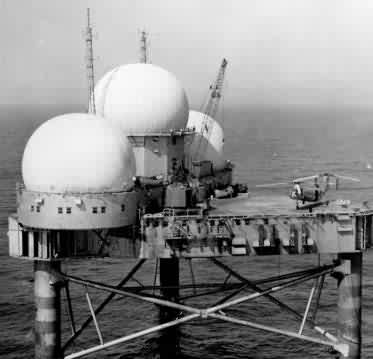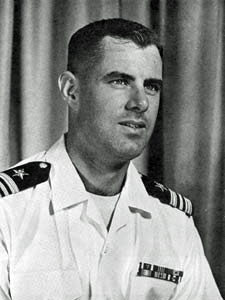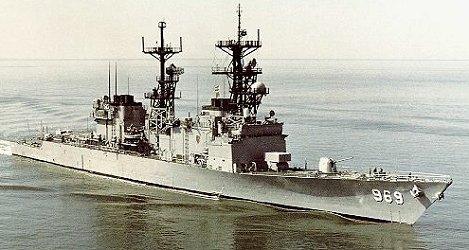|
On 1 January 1961, McCaffery was moored at Newport, R.I. Commanding officer - CDR R.D. Fisher.
On 9 January, McCaffery got underway for various exercises and drills while operating with Wasp (CVS-18). Extremely bad
weather closed in on 14 January. The next day, DESRON 24, including McCaffery, Fred T. Berry, Lyod Thomas, and Wasp, became part of a
rescue mission for 28 crew members of Texas Tower #4 that were waiting desperately to be evacuated from the tower because the platform was
breaking up.

The five Texas Towers were intended to become part of the USA's advanced early warning radar system against Soviet bombers. Towers 1 & 5
were never built. Towers 2 & 3 were situated on the rocky seabed off Nantucket and Boston respectively, and Tower 4 was located 84 miles
southeast of New York City, placed in waters twice as deep as Towers 2 & 3, and on a soft bed of sand and mud. The structure stood on
three legs, each 100m long and 4m thick. When the tower was floated out to its location, two tower leg braces were damaged by a vicious gale.
New leg braces were attached, as shown in the picture. However, the first crew members found the entire tower unstable.
In August 1959, Hurricane Daisy severly damaged the isolated base, and Hurricane Donna pounded the tower with 130mph winds in September 1960,
weakening the legs further. By this point, Texas Tower 4 had acquired a new name: Old Shaky. As well as rocking from side to side, the
platform twisted and leaned, creaking horribly as it did. The crew was in constant fear that they would be pitched into the freezing ocean.
With squalls packing winds approaching 60 knots on 14 January, a deafing crack echoed across the platform, and Old Shaky began to sway
horribly - another leg brace had snapped. An evacuation order was granted at 4 PM shortly before the tower's legs failed and the tower slipped
beneath the sea. Meanwhile, McCaffery along with the Fred T. Berry and Lloyd Thomas were steaming with Wasp when word of the disaster reached them.
Rear Admiral Allen M. Shinn, Commander Carrier Division 14, on the Wasp, ordered the three destroyers to speed to the scene - about 40 miles away.
McCaffery was the the first ship to locate the wreckage. Contact was made by McCaffery's sonar equipment of underwater wreckage, and other attempts
were made by "CW" underwater radio to determine if anyone was trapped in the submerged wreckage. As soon as Adm. Shinn was informed of the McCaffery's
confirmed contact, he called for volunteer divers and a boat crew from McCaffery to investigate. Lt(jg) Beveradge L. Cash, an amateur diver, volunteered
at once.
As McCaffery maneuvered close to site of the submerged wreckage, the motor whaleboat was lowered from the ship with a volunteer crew that consisted of
L.C. Hedin, EM; R.R. Despathy, SFP3; J.R. Harold, FN; T.W. Noonan, SM1; E.F. Van Kampen, RM1; W.A. Showers, BM3; R.K. Blair, SN; J.A. Hewitt, EN3;
and Ens. Robert W. Raymond, boat commander in Cash's absence. Lt(jg) Cash got into the water, and made a shallow dive of 10 or 15 feet. Three men tended
the lines that prevented him from being swept away by the swift currents, and supplied him with his air from the surface, forced down to him from a small
hand pump. When his face mask started to fill with water, he came to the surface. Just before he surfaced, Cash was sure he'd spotted the shimmering
of a metal object some 40 feet below him. Breaking water, he yelled his discovery to the nine men in the boat bobbing crazily in the 25-foot swells,
adjusted his face mask, and plunged back into the icy water. He tried to swim to one of the tower's supports - a stanchion that was grotesque and
desolate without the tower above it. Again, when he descended about 15 feet, he saw a reflection 40 feet down. Again, his face mask began to fill
with water, and he had to come to the surface.
As soon as he had cleared the mask, he started down, trying to descend deeper than 15 feet, and reach the tower's compartments. There were small
oxygen tanks in the boat to carry down to any survivors contacted inside the compartments. Topside, the men in the small boat were tense as Cash repeated his
attempts to reach the dome. To make the situation more miserable, there was a low overcast with 30-40-knot winds whipping up a stinging spray. It was
hazardous, time-consuming work, and Cash was wearing only a pair of "long johns" under his thin rubber suit. After 30 minutes in the numbing water, the three
line tenders hauled him into the boat, and he ordered the crew to make for the McCaffery. After his frustrating time in the water, Cash and the crew were
heading back. When they came alongside, they found themselves riding the swells' crest up to the McCaffery 01 level and troughs to the bilge keel. It took
some expert seamanship on the part of the boat crew and the ship's crew before they were lifted aboard.
By this time, the destroyer USS Blandy(DD-943) arrived with civilian skin divers who had been flown to her from the Wasp by helicopter. Cash was airlifted to the Blandy
via helicopter. After he narrated his experiences, it was decided that he would accompany the divers to the tower area. Late that afternoon, the divers entered
the water, and, although they descended deeper than Cash, they found their efforts were hampered by the murky waters stirred up by the storm. Later secure
attempts were called off, pending the arrival of deep-sea divers on the Sunbird, a submarine rescue vessel. Subsequent rescue attempts by personnel from
Coast Guard and New York civilian units, were unsuccessful. Only one body was pulled from the water. On 20 January, McCaffery returned to Newport.
For their actions, both Lt(jg) Cash and Salvatore A. Esposito, McCaffery sonar man who reported tappings, were recommended for the Navy Commendation Medal,
and official citations were entered into their service records.
On 13 February, McCaffery got underway for ASW exercises with Trout (SS-565), which included a simulated atomic underwater burst.
On 21 February, McCaffery conducted firing exercises at Target Bay, Culebra Island, and then proceeded to San Juan, Puerto Rico. Gunnery
exercises continued through 25 February, and then McCaffery made a simulated attack on the guided missile cruiser Canberra (CAG-2). In the
exercises that followed, she operated between San Juan, Culebra Island, Vieques Island, and St. Thomas. McCaffery returned to Newport
on 11 March.
On 11 April, McCaffery moved to the Brooklyn Navy Yard for Fleet Rehabilitation And Modernization (FRAM II) overhaul. FRAM II was
designed to add five years to the life of the ship, update weapons systems, and to improve living quarters. The overhaul gave her a
new profile, a new bridge, a new tripod mast, replacement of the original torpedo tubes with smaller ASW torpedo tubes, an Electronic
Counter Measures (ECM) mast aft, and a hanger and hanger deck for the Drone Antisubmarine Helicopter - DASH. During the extended
overhaul, the crew members spent over 2,000 man days at various training facilities on the East Coast. On 6 May McCaffery entered
dry dock, and remained there until 1 July. She entered dry dock several times more during the yard period.
|



